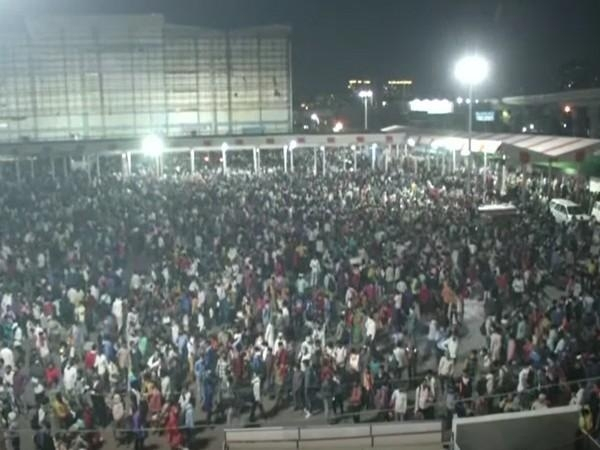Ever since the 21-day lockdown in India was imposed on 24 March to contain COVID-19, images of thousands of migrants workers in metropolitan cities such as Mumbai and Delhi journeying hundreds of kilometers on foot to their native places have received widespread coverage.
Despite the country's Prime Minister, Narendra Modi, announcing a relief package of $22 billion, and Chief Ministers in several states announcing similar arrangements, panic has gripped these poor migrant workers from rural parts of India.
However, in the midst of this pandemonium, one question begs to be asked. Will this mass exodus set off a wave of COVID-19 infections across several states in the second-most populous country in the world?

Crisis in capital New Delhi
Several migrant workers in the country's capital belong to the states of Bihar, Madhya Pradesh and Uttar Pradesh, among others. After the imposition of the lockdown, they found themselves stranded without any means to fend for themselves and decided to head home for safety. While some left on foot, others tried to reach their destinations by bus or any other means. The problem, however, is the sheer numbers.
In what can be considered a crisis within a crisis, thousands of panicked workers descended upon the Anand Vihar bus station and other prime transit spots in Delhi on Saturday, jeopardising the social distancing measures that the lockdown aimed for. With the limited number of buses available, workers crammed every inch of the buses including rooftops.
Appeals from the Chief Minister of Delhi, Arvind Kejriwal, to remain in the city were of no anvil as workers stayed rooted. " About 100 buses of Delhi government and around 200 buses of Uttar Pradesh government are carrying people trying to walk from Delhi. Nevertheless, I appeal to everyone to follow the lockdown. This is the solution to keep the corona effect under control. Corona is in complete danger of exiting," he tweeted.
To restrict the movement of workers across borders and for those who have managed to get home, the Central government has issued strict directives to state governments to impose mandatory quarantine rules.
"Those who travel during the period of lockdown will be subjected to a minimum 14 days of quarantine in government quarantine facilities," said the statement. Currently, several measures are being put in place to mitigate the crisis. However, is it too little too late?
A Wuhan pattern playing out?
One of the primary reasons attributed to the spread of the coronavirus in China was the travel associated with Lunar New Year around the time of the outbreak. The Chinese authorities began sealing the borders of the city on January 23. However, while speaking to reporters a few days after the city was placed under quarantine, the Mayor of Wuhan said approximately five million people had already left the city before the clampdown.
However, in the Delhi scenario, officials are being forced to let people leave; increasing the chances of letting possibly infected individuals carry the virus with them to the rural parts of several states.
"Given that travel right now is our biggest source of infections, this great movement from cities to rural areas is only going to make it worse," said Shamika Ravi, the director of research at Brookings India, a think-tank, according to Financial Times, only a few days ago as the problem began brewing.
Crowds that can affect thousands
While Wuhan is an example of how mass movement can cause the spread of disease, Italy's "Game Zero" shows how crowds congregating at a single place can lead to infections.
Held on February 19, nearly one-third of the population of Bergamo, one of the worst-hit regions in Italy, travelled to Milan's San Siro Stadium to witness a soccer match between Italian club Atalanta BC and Spanish club Valencia. Nearly 2,500 fans from Spain also travelled to the city for the match. The fixture was held just two days before the first local case was reported.
While much has been discussed about the spread at the game, Fabiano di Marco, the chief pneumologist at a hospital in Bergamo, summarized the entire episode and told Italian newspaper Corriere della Sera: "I have heard a lot (of theories), I'll say mine: Feb. 19, 40,000 Bergamaschi went to San Siro for Atalanta-Valencia. In buses, cars, trains. A biological bomb, unfortunately."
Delhi crisis a mixture of both scenarios
The ongoing exodus crisis in Delhi is probably a mixture of both scenarios. Thousands of untested people gathering in hordes with no social distancing and travelling to other parts of the country. This crisis is not confined to Delhi but has been witnessed across several metropolitan cities, with state governments ferrying workers to their home states.
While only time can tell if the exodus will become a "bomb", state governments receiving migrant workers are putting quarantine measures in place to reduce the risk of transmission of COVID-19 in their states. "All of these migrant labourers have to stay in a government camp for 14 days. They would not be allowed to return to their homes," said UP Deputy Chief Minister Keshav Prasad Maurya, according to NDTV.
Bihar's Chief Minister Nitish Kumar has also ordered officials to establish relief camps for migrant workers from where they can head home after their quarantine periods. He told NDTV: "This entire exercise to send back people to their (native) states by special buses will defeat the purpose of lockdown. It will lead to an increase in the spread of virus in the next few days."









